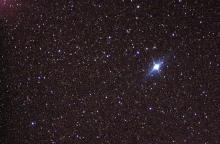Listen to today's episode of StarDate on the web the same day it airs in high-quality streaming audio without any extra ads or announcements. Choose a $8 one-month pass, or listen every day for a year for just $30.
You are here
More Canopus
Finding your way to the other bodies of the solar system is a tough chore. They’re a long way away, they’re relatively small targets, and they’re in constant motion. So it helps to have some navigational beacons to guide you.
One of those beacons is the Sun — the brightest object in the sky. And for many spacecraft, another is Canopus, the second-brightest star in the night sky. It’s a long way from the Sun, so tracking both objects allows a craft to triangulate its position. That provides a precise track of its location in space.
Canopus would make a good navigational beacon for any civilization within a thousand light-years of it. That’s because it’s extremely bright — more than 10 thousand times brighter than the Sun. So even though it’s more than 300 light-years away, it outshines all the other stars except Sirius, which is less than nine light-years away.
Canopus shines so bright because of its size and surface temperature. It’s about 70 times the Sun’s diameter, and its surface is thousands of degrees hotter. The combination makes Canopus one of the most impressive stars in our part of the galaxy.
And Canopus is also a good beacon for skywatchers in the far south of the United States — south of about Dallas or Little Rock. Right now, it stands just above the southern horizon about an hour and a half after sunset. It’s almost directly below Sirius, which is much higher — a lineup of the two brightest stars in the night sky.
Script by Damond Benningfield



